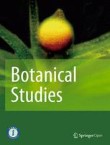The level of genetic diversity and differentiation of tropical lotus, Nelumbo nucifera Gaertn. (Nelumbonaceae) from Australia, India, and Thailand
Nelumbo nucifera Gaertn., a perennial aquatic macrophyte species, has been cultivated in several Asian countries for its economic importance, and medicinal uses. Two distinct ecotypes of the species are recognize...
